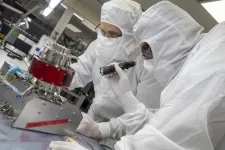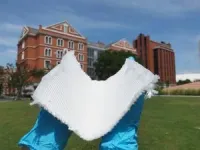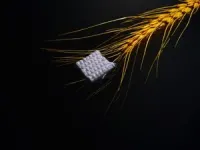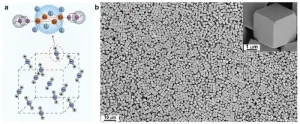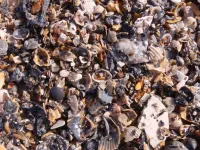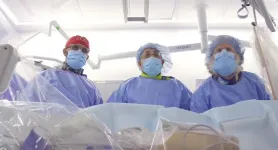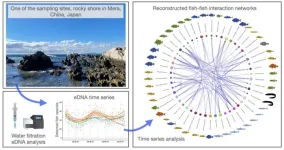(Press-News.org) SAN ANTONIO — July 11, 2023 —Southwest Research Institute has delivered a plasma spectrometer for integration into a lunar lander as part of NASA’s Lunar Vertex investigation, scheduled to commence next year. The target site is the Reiner Gamma region on the Moon’s nearside, a mysterious area known to have a local magnetic field. The SwRI-developed Magnetic Anomaly Plasma Spectrometer (MAPS) will study the interaction of the solar wind with surface materials on the Moon, aiming to understand the origin of the sinuous patterns of bright and dark soil, known as lunar swirls, that correspond with anomalous regions of magnetic rocks.
“MAPS is the latest generation of the spectrometer that originally flew on ESA’s Rosetta mission to comet 67P/Churyumov-Gerasimenko,” said SwRI’s Dr. Jörg-Micha Jahn, MAPS lead investigator. “We will investigate how the influx of the solar wind interacts with the localized magnetic fields and how it could affect features on the lunar surface. The spectrometer will help us determine if charged particles delivered by the solar wind even make it to the surface of the Moon within a magnetic anomaly.”
Unlike Earth, the Moon does not have a global magnetic field that protects it from the supersonic solar wind. As these streams of energetic particles hit the lunar surface, magnetic patches bend the trajectories of the solar particles, acting like an umbrella. The Johns Hopkins Applied Physics Laboratory (APL) is leading the Lunar Vertex investigation of Reiner Gamma to understand conditions on the Moon and other airless worlds throughout the solar system.
“MAPS represents the fastest turnaround of any space science instrument built by SwRI. It has been a remarkable effort by our staff to design, build, test and deliver a complex plasma instrument in such a short amount of time,” said SwRI’s Prachet Mokashi, MAPS project manager.
MAPS will gather sensitive, high-resolution insights that spacecraft orbiting around the Moon cannot achieve. It offers more than four times higher resolution than instruments typically orbiting around Earth or the Moon, yet it weighs only 11 pounds (five kilograms) and draws less than 6 watts of power. Just as a spectrometer separates light into its constituent wavelengths, a particle spectrometer separates particles according to their energy and direction of travel. This three-dimensional “picture” of the charged particles will reveal how the solar wind has been altered by the magnetic fields at Reiner Gamma.
“I find this project to be very rewarding personally,” Jahn said. “When you work in a field as esoteric as space plasma physics, it is nice to be able to point to something as familiar as the Moon and to know that an instrument you developed will be up there helping us to understand Earth’s closest neighbor. We are looking for clues to unravel the magnetic mysteries of the Moon and what they tell us about its formation and evolution.”
MAPS will also help scientists understand space weathering, the continuous surface erosion of objects ranging from rocky planets to moons, asteroids and comets. The space weathering process darkens the lunar soil through the combined accumulation of micrometeoroid impacts, energetic radiation bombardment, and the constant stream of particles from the solar wind. For context, the Rosetta instrument found that electrons near its target comet cause rapid breakup of water and carbon dioxide molecules released from the comet’s nucleus, not photons from the Sun, as had been believed.
“The beautiful patterns of bright and dark materials in the magnetic regions could reveal the effects of magnetism on surface weathering,” Jahn said. “Nearby regions not protected by magnetic fields serve as controls. Lunar Vertex could help us quantify space weathering and the relative roles of solar wind exposure versus the effects from cosmic dust hitting the surface. Scientists could then apply this to understand the history and evolution of airless bodies across the solar system.”
Lunar Vertex was competitively selected as NASA’s first Payloads and Research Investigations on the Surface of the Moon (PRISM) delivery. PRISM is managed by the NASA Planetary Mission Program Office under the Artemis program. PRISM solicits science investigations that will reach the Moon on commercial landers selected through the Commercial Lunar Payload Services (CLPS) initiative. NASA initiated CLPS in 2018 to spur rapid acquisition of lunar delivery services from American companies for payloads that advance capabilities for science, exploration, or commercial development of the Moon. NASA, via CLPS, selected Intuitive Machines in Houston to provide the lunar lander delivery service for Lunar Vertex. Dr. David Blewett of the Johns Hopkins Applied Physics Laboratory in Laurel, Maryland, leads Lunar Vertex.
For more information, visit https://www.swri.org/planetary-science.
END
SwRI delivers plasma spectrometer for Moon mission
Magnetic Anomaly Plasma Spectrometer will study the impact of solar wind particles on lunar surface
2023-07-11
ELSE PRESS RELEASES FROM THIS DATE:
Efficient X-ray luminescence imaging with ultrastable and eco-friendly copper(I)-iodide cluster microcubes
2023-07-11
Scintillators are optical materials that emit low-energy ultraviolet and visible photons in response to ionizing radiation such as X-rays and gamma rays. This property makes scintillating materials useful for applications like non-destructive testing, X-ray astronomy, security inspection, and medical imaging.
In a recently published paper in Light Science & Applications, Professor Xiaowang Liu and Academician Wei Huang, along with their team from the Institute of Flexible Electronics at Northwestern Polytechnical University, ...
Ohio teen and Florida veteran named first national heart health program winners
2023-07-11
DALLAS, July 11, 2023 — Two dedicated volunteers have reached a prestigious milestone with the American Heart Association, the world’s leading nonprofit organization devoted to a world of healthier lives for all, for their personal passion and commitment to advance women’s heart health.
For the third year, changemakers across the country were nominated to join the American Heart Association’s Woman of Impact and Teen of Impact® campaigns. Aligning with the Go Red for Women® movement, the Association’s signature ...
Xerces Blue butterfly genome sequenced, an icon of anthropogenic extinction
2023-07-11
The Xerces Blue butterfly (Glaucopsyche xerces) was native to the coastal dunes of San Francisco, in the United States. As the city grew, much of the butterfly’s habitat was destroyed and its population was relegated to Golden Gate National Park. Its wings were a deep iridescent blue, with characteristic white spots on the ventral side. The last surviving specimens of the species were found in 1941, by entomologist W. Harry Lange. It is considered the first insect species to have become extinct in historical times. Its disappearance has made it a global icon of anthropogenic extinction, to ...
Bacteria in kitchen may not be as harmful as you think
2023-07-11
Washington, D.C. – Bacteria found in 74 kitchens spread among 5 European countries were mostly harmless according to new research published in Applied and Environmental Microbiology, a journal of the American Society for Microbiology.
“We have previously found considerable variations in kitchen standards, food preparation practices, and cleaning regimes between France, Norway, Portugal, Romania, and Hungary,” said Birgitte Moen, Ph.D., Scientist—Department of Food Safety and Quality, Nofima—Norwegian Institute of Food, Fisheries, and Aquaculture Research, Ås, Norway.
In ...
Allen Institute for Neural Dynamics launches first-ever crowdsourced neuroscience experiment
2023-07-11
The aim is to maximize impact by turning to the combined talent and insight of the broader international neuroscience community.
SEATTLE — July 11, 2023 — Today, scientists from the Allen Institute for Neural Dynamics, a division of the Allen Institute, launched the world’s first completely open- and crowd-sourced neuroscience experiment—inviting researchers from around the world to publicly design a shared experiment that will run on the Allen Brain Observatory, as part of the Institute’s OpenScope program. Experiments will probe ...
Marine fossils are a reliable benchmark for degrading and collapsing ecosystems
2023-07-11
Biologists attempting to conserve and restore denuded environments are limited by their scant knowledge of what those environments looked like before the arrival of humans. This is especially true of coastal ecosystems, many of which had already been drastically altered by pollution and overharvesting hundreds of years before scientists began monitoring them.
According to a new study published in the journal PeerJ, a faithful analogue of modern marine ecosystems lies just beneath the surface. Building on more than 20 years of conservation paleobiology, the results suggest that fossils of various marine groups — including worms, mollusks, crabs and sea urchins — are ...
Mount Sinai Queens opens new Cardiac Catheterization Lab to expedite care for heart attack patients
2023-07-11
Click here to watch a video on the new Cath Lab
Mount Sinai Queens today announced the opening of a new cardiac catheterization lab that will provide rapid and comprehensive care to hundreds of heart patients every year for life-threatening emergencies and scheduled cardiac procedures. The first cardiac catheterization lab in Astoria, it will transform treatment for patients in the growing communities of western Queens by vastly improving access to cardiac care in the borough and beyond.
Atul Kukar, DO, has been named the Director of the Mount Sinai Queens Catheterization Lab and leads a team of 14 specialists including interventional cardiologists, nurses, and technicians.
“Our ...
The ground is deforming, and buildings aren’t ready
2023-07-11
There is a “silent hazard” lurking underneath our major global cities, and our buildings were not designed to handle it.
A new Northwestern University study has, for the first time, linked underground climate change to the shifting ground beneath urban areas. As the ground heats up, it also deforms. This phenomenon causes building foundations and the surrounding ground to move excessively (due to expansions and contractions) and even crack, which ultimately affects structures’ long-term operational performance and durability. Researchers also report that past building damage ...
Deciphering fish species interactions for climate change insights
2023-07-11
A team led by the Hong Kong University of Science and Technology (HKUST) has developed a technique to study how different fish species interact with each other in a coastal region, a breakthrough that helps explain the complex relationships among marine species and how global warming impacts fish populations.
By analyzing minute traces of fish DNA from samples of seawater, the team combined the use of environmental DNA – known as eDNA – and advanced statistical analysis to not only detect ...
Simple oxygen intervention could help patients ‘dramatically improve’ after brain injuries
2023-07-11
Motor learning skills let us move through the world: we use them to teach ourselves how to walk, how to pick up a drink, how to run. But age or sickness can weaken our ability to learn motor tasks. Scientists studying the impact of oxygen supplementation on motor learning have found a promising treatment that could help patients who have experienced neurological trauma recover old skills.
“A simple and easy to administer treatment with 100% oxygen can drastically improve human motor learning processes,” said Dr Marc Dalecki, now at the German University of Health and Sports in Berlin, senior author of the study in Frontiers in Neuroscience.
Repurposing ...
LAST 30 PRESS RELEASES:
Making lighter work of calculating fluid and heat flow
Normalizing blood sugar can halve heart attack risk
Lowering blood sugar cuts heart attack risk in people with prediabetes
Study links genetic variants to risk of blinding eye disease in premature infants
Non-opioid ‘pain sponge’ therapy halts cartilage degeneration and relieves chronic pain
AI can pick up cultural values by mimicking how kids learn
China’s ecological redlines offer fast track to 30 x 30 global conservation goal
Invisible indoor threats: emerging household contaminants and their growing risks to human health
Adding antibody treatment to chemo boosts outcomes for children with rare cancer
Germline pathogenic variants among women without a history of breast cancer
Tanning beds triple melanoma risk, potentially causing broad DNA damage
Unique bond identified as key to viral infection speed
Indoor tanning makes youthful skin much older on a genetic level
Mouse model sheds new light on the causes and potential solutions to human GI problems linked to muscular dystrophy
The Journal of Nuclear Medicine ahead-of-print tip sheet: December 12, 2025
Smarter tools for peering into the microscopic world
Applications open for funding to conduct research in the Kinsey Institute archives
Global measure underestimates the severity of food insecurity
Child survivors of critical illness are missing out on timely follow up care
Risk-based vs annual breast cancer screening / the WISDOM randomized clinical trial
University of Toronto launches Electric Vehicle Innovation Ontario to accelerate advanced EV technologies and build Canada’s innovation advantage
Early relapse predicts poor outcomes in aggressive blood cancer
American College of Lifestyle Medicine applauds two CMS models aligned with lifestyle medicine practice and reimbursement
Clinical trial finds cannabis use not a barrier to quitting nicotine vaping
Supplemental nutrition assistance program policies and food insecurity
Switching immune cells to “night mode” could limit damage after a heart attack, study suggests
URI-based Global RIghts Project report spotlights continued troubling trends in worldwide inhumane treatment
Neutrophils are less aggressive at night, explaining why nighttime heart attacks cause less damage than daytime events
Menopausal hormone therapy may not pose breast cancer risk for women with BRCA mutations
Mobile health tool may improve quality of life for adolescent and young adult breast cancer survivors
[Press-News.org] SwRI delivers plasma spectrometer for Moon missionMagnetic Anomaly Plasma Spectrometer will study the impact of solar wind particles on lunar surface
